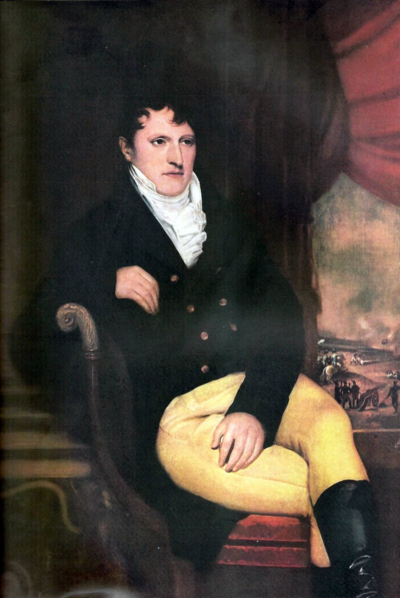The royalists were the people of Hispanic America (mostly from native and indigenous peoples) and European that fought to preserve the integrity of the Spanish monarchy during the Spanish American wars of independence.
In the early years of the conflict, when King Ferdinand VII was captive in France, royalists supported the authority in the Americas of the Supreme Central Junta of Spain and the Indies and the Cortes of Cdiz that ruled in the King's name during the Peninsular War. During the Trienio Liberal in 1820, after the restoration of Ferdinand VII in 1814, the royalists were split between Absolutists, those that supported his insistence to rule under traditional law, and liberals, who sought to reinstate the reforms enacted by the Cortes of Cdiz.
Manuel José Joaquín del Corazón de Jesús Belgrano y González (3 June 1770 – 20 June 1820), usually referred to as Manuel Belgrano (Spanish pronunciation: [mãˈnwel βelˈɣɾano]), was an Argentine economist, lawyer, politician, journalist, and military leader. He took part in the Argentine Wars of Independence and created the Flag of Argentina. He is regarded as one of the main Libertadores of the country.
Belgrano was born in Buenos Aires, the fourth child of Italian businessman Domingo Belgrano y Peri and María Josefa González Casero. He came into contact with the ideas of the Age of Enlightenment while at university in Spain around the time of the French Revolution. Upon his return to the Viceroyalty of the Río de la Plata, where he became a notable member of the criollo population of Buenos Aires, he tried to promote some of the new political and economic ideals, but found severe resistance from local peninsulars. This rejection led him to work towards a greater autonomy for his country from the Spanish colonial regime. At first, he unsuccessfully promoted the aspirations of Carlota Joaquina to become a regent ruler for the Viceroyalty during the period the Spanish King Ferdinand VII was imprisoned during the Peninsular War (1807–1814). He favoured the May Revolution, which removed the viceroy Baltasar Hidalgo de Cisneros from power on 25 May 1810. He was elected as a voting member of the Primera Junta that took power after the ouster.
As a delegate for the Junta, he led the ill-fated Paraguay campaign. His troops were defeated by Bernardo de Velasco at the battles of Campichuelo and Paraguarí. Though he was defeated, the campaign initiated the chain of events that led to the Independence of Paraguay in May 1811. He retreated to the vicinity of Rosario, to fortify it against a possible royalist attack from the Eastern Band of the Uruguay River. While there, he created the flag of Argentina. The First Triumvirate did not approve the flag, but because of slow communications, Belgrano would only learn of that many weeks later, while reinforcing the Army of the North at Jujuy. There, knowing he was at a strategic disadvantage against the royalist armies coming from Upper Peru, Belgrano ordered the Jujuy Exodus, which evacuated the entire population of Jujuy Province to San Miguel de Tucumán. His counter-offensive at the Battle of Tucumán resulted in a key strategic victory, and it was soon followed by a complete victory over the royalist army of Pío Tristán at the Battle of Salta. However, his deeper incursions into Upper Perú led to defeats at Vilcapugio and Ayohuma, leading the Second Triumvirate to order his replacement as Commander of the Army of the North by the newly arrived José de San Martín. By then, the Asamblea del Año XIII had approved the use of Belgrano's flag as the national war flag.
Belgrano then went on a diplomatic mission to Europe along with Bernardino Rivadavia to seek support for the revolutionary government. He returned in time to take part in the Congress of Tucumán, which declared Argentine Independence (1816). He promoted the Inca plan to create a constitutional monarchy with an Inca descendant as Head of State. This proposal had the support of San Martín, Martín Miguel de Güemes, and many provincial delegates, but was strongly rejected by the delegates from Buenos Aires. The Congress of Tucumán approved the use of his flag as the national flag. After this, Belgrano again took command of the Army of the North, but his mission was limited to protecting San Miguel de Tucumán from royalist advances while San Martín prepared the Army of the Andes for an alternative offensive across the Andes. When Buenos Aires was about to be invaded by José Gervasio Artigas and Estanislao López, he moved the Army southwards, but his troops mutinied in January 1820. Belgrano died of dropsy on 20 June 1820. His last words reportedly were: "¡Ay, Patria mía!" (Oh, my country!).

1813Feb, 20
Manuel Belgrano defeats the royalist army of Pío de Tristán during the Battle of Salta.
Choose Another Date
Events on 1813
- 28Jan
Pride and Prejudice
Jane Austen's Pride and Prejudice is first published in the United Kingdom. - 1Jun
USS Chesapeake (1799)
James Lawrence, the mortally-wounded commander of the USS Chesapeake, gives his final order: "Don't give up the ship!" - 30Sep
Santiago Bobadilla
Battle of Bárbula: Simón Bolívar defeats Santiago Bobadilla. - 16Oct
Battle of Leipzig
The Sixth Coalition attacks Napoleon Bonaparte in the Battle of Leipzig. - 11Nov
Battle of Crysler's Farm
War of 1812: Battle of Crysler's Farm: British and Canadian forces defeat a larger American force, causing the Americans to abandon their Saint Lawrence campaign.

 English
English  español
español  français
français  português
português  русский
русский  العربية
العربية  简体中文
简体中文 